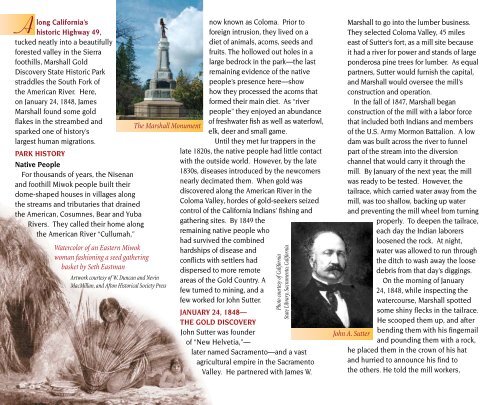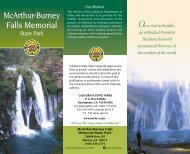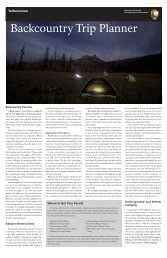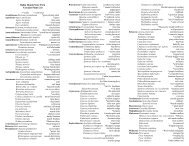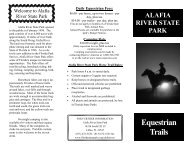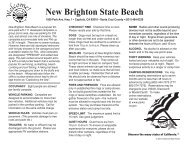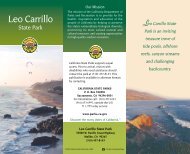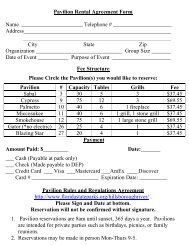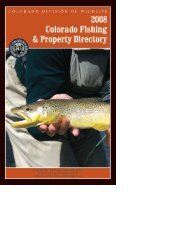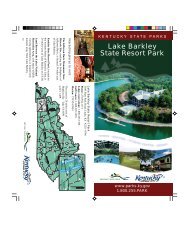Create successful ePaper yourself
Turn your PDF publications into a flip-book with our unique Google optimized e-Paper software.
Along California’s<br />
historic Highway 49,<br />
tucked neatly into a beautifully<br />
forested valley in the Sierra<br />
foothills, Marshall Gold<br />
Discovery State Historic <strong>Park</strong><br />
straddles the South Fork of<br />
the American River. Here,<br />
on January 24, 1848, James<br />
Marshall found some gold<br />
flakes in the streambed and<br />
sparked one of history’s<br />
largest human migrations.<br />
PARK HISTORY<br />
Native People<br />
For thousands of years, the Nisenan<br />
and foothill Miwok people built their<br />
dome-shaped houses in villages along<br />
the streams and tributaries that drained<br />
the American, Cosumnes, Bear and Yuba<br />
Rivers. They called their home along<br />
the American River “Cullumah,”<br />
Watercolor of an Eastern Miwok<br />
woman fashioning a seed gathering<br />
basket by Seth Eastman<br />
The Marshall Monument<br />
Artwork courtesy of W. Duncan and Nevin<br />
MacMillan, and Afton Historical Society Press<br />
now known as Coloma. Prior to<br />
foreign intrusion, they lived on a<br />
diet of animals, acorns, seeds and<br />
fruits. The hollowed out holes in a<br />
large bedrock in the park—the last<br />
remaining evidence of the native<br />
people’s presence here—show<br />
how they processed the acorns that<br />
formed their main diet. As “river<br />
people” they enjoyed an abundance<br />
of freshwater fish as well as waterfowl,<br />
elk, deer and small game.<br />
Until they met fur trappers in the<br />
late 1820s, the native people had little contact<br />
with the outside world. However, by the late<br />
1830s, diseases introduced by the newcomers<br />
nearly decimated them. When gold was<br />
discovered along the American River in the<br />
Coloma Valley, hordes of gold-seekers seized<br />
control of the California Indians’ fishing and<br />
gathering sites. By 1849 the<br />
remaining native people who<br />
had survived the combined<br />
hardships of disease and<br />
conflicts with settlers had<br />
dispersed to more remote<br />
areas of the Gold Country. A<br />
few turned to mining, and a<br />
few worked for John Sutter.<br />
Photo courtesy of California<br />
State Library, Sacramento, California<br />
January 24, 1848—<br />
THE GOLD DISCOVERY<br />
John Sutter was founder<br />
of “New Helvetia,”—<br />
later named Sacramento—and a vast<br />
agricultural empire in the Sacramento<br />
Valley. He partnered with James W.<br />
Marshall to go into the lumber business.<br />
They selected Coloma Valley, 45 miles<br />
east of Sutter’s fort, as a mill site because<br />
it had a river for power and stands of large<br />
ponderosa pine trees for lumber. As equal<br />
partners, Sutter would furnish the capital,<br />
and Marshall would oversee the mill’s<br />
construction and operation.<br />
In the fall of 1847, Marshall began<br />
construction of the mill with a labor force<br />
that included both Indians and members<br />
of the U.S. Army Mormon Battalion. A low<br />
dam was built across the river to funnel<br />
part of the stream into the diversion<br />
channel that would carry it through the<br />
mill. By January of the next year, the mill<br />
was ready to be tested. However, the<br />
tailrace, which carried water away from the<br />
mill, was too shallow, backing up water<br />
and preventing the mill wheel from turning<br />
properly. To deepen the tailrace,<br />
each day the Indian laborers<br />
loosened the rock. At night,<br />
water was allowed to run through<br />
the ditch to wash away the loose<br />
debris from that day’s diggings.<br />
On the morning of January<br />
24, 1848, while inspecting the<br />
watercourse, Marshall spotted<br />
some shiny flecks in the tailrace.<br />
He scooped them up, and after<br />
John A. Sutter<br />
bending them with his fingernail<br />
and pounding them with a rock,<br />
he placed them in the crown of his hat<br />
and hurried to announce his find to<br />
the others. He told the mill workers,


